This section provides an overview of the 48V electric scooter wiring diagram, highlighting its purpose, key components, and importance for safe and efficient operation. The manual guides users through understanding connections, troubleshooting, and maintaining their scooter’s electrical system effectively.
1.1 Overview of the Owner’s Manual
The owner’s manual for a 48V electric scooter is a comprehensive guide designed to help users understand and maintain their vehicle. It includes detailed wiring diagrams, safety precautions, and operational instructions. The manual covers essential components like the motor, battery, and controller, ensuring users can troubleshoot and repair issues effectively. Key sections include power specifications, wiring harness connections, and voltage requirements. By following the manual, users can ensure optimal performance and longevity of their scooter; It also provides step-by-step instructions for connecting components like the throttle, brakes, and speed controller. Understanding the manual is crucial for safe and efficient operation of the 48V electric scooter.
1.2 Importance of Understanding the Wiring Diagram
Understanding the wiring diagram is crucial for the safe and efficient operation of a 48V electric scooter. It helps users identify connections between components like the motor, battery, and controller. Proper knowledge prevents short circuits and ensures all parts function correctly. The diagram guides troubleshooting, allowing users to diagnose issues quickly. It also aids in upgrading or replacing components, ensuring compatibility and safety. By following the wiring diagram, users can maintain their scooter’s performance and longevity, avoiding potential electrical hazards. This knowledge is essential for both routine maintenance and advanced modifications, making it a cornerstone of scooter ownership and customization.
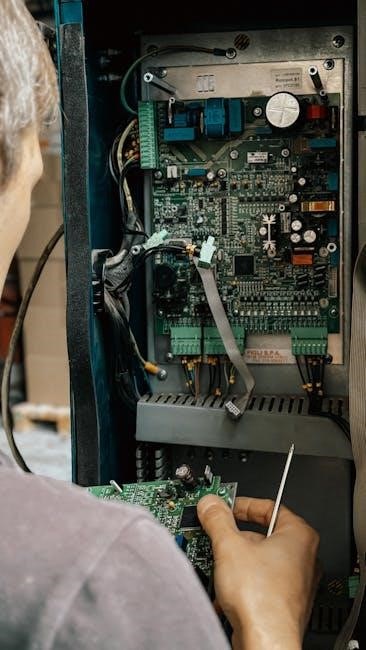
Understanding the 48 Volt Electric Scooter Wiring Diagram
Understanding the wiring diagram is essential for identifying connections between components like the motor, controller, and battery. It uses symbols to represent parts and their interconnections, ensuring safe and proper installation. The diagram also specifies voltage requirements, helping users avoid electrical hazards and maintain optimal performance. This knowledge is vital for troubleshooting and upgrading components, making it a fundamental tool for scooter maintenance and customization.
2.1 Key Components of the Wiring System
The wiring system of a 48V electric scooter includes essential components such as the battery, motor, controller, throttle, brake sensors, and power lines. The battery provides the power, while the motor converts electrical energy into motion. The controller regulates the flow of power between the battery and motor. The throttle adjusts speed, and brake sensors ensure safe stopping. Power lines connect these components, enabling communication and energy transfer. Additionally, sensors monitor performance, and indicators provide feedback. Understanding these components is crucial for diagnosing issues and ensuring proper functionality. Each part plays a vital role in the scooter’s operation, making the wiring system a complex yet essential network.
2.2 Reading the Wiring Diagram: Symbols and Notations
Understanding the symbols and notations in a 48V electric scooter wiring diagram is essential for proper setup and troubleshooting. Common symbols include circles for connectors, lines for wires, and color-coded wires for specific functions. For example, green often represents a 1-4 Volt signal input, while black denotes negative or ground connections. Pink and white wires may indicate cruise control or brake switch contacts. Notations like “V+” and “V-” mark positive and negative battery terminals. Arrows or dashed lines show the flow of power or signal paths. Familiarizing yourself with these symbols ensures accurate connections and helps identify potential issues quickly. Always refer to the diagram’s legend for clarity, as variations may exist between models or manufacturers.
2.3 Voltage and Power Specifications
The 48V electric scooter wiring diagram specifies the operating voltage range, typically between 30V and 59V DC, ensuring compatibility with 36V or 48V battery packs. The power rating, such as 500W or 800W, determines the motor’s performance and energy consumption. Current limits, often set at 30A or 45A, prevent overheating and damage. Low-voltage protection is crucial to maintain battery health, disconnecting the system when voltage drops below safe levels. These specifications ensure efficient energy use and safety. Always verify the controller’s voltage and power ratings match the motor and battery to avoid system overload. Adhering to these guidelines ensures optimal scooter performance and longevity of electrical components.
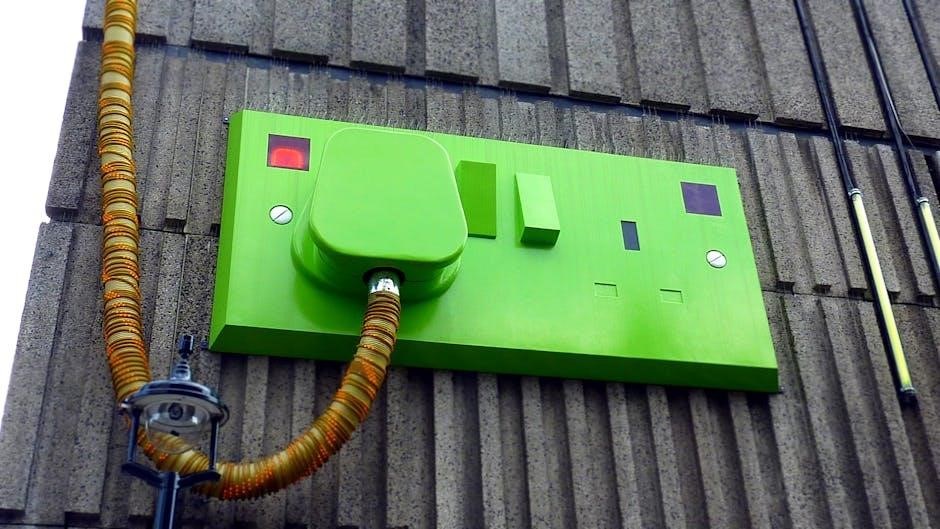
Components of the 48 Volt Electric Scooter
The 48V electric scooter comprises a motor, controller, battery, throttle, brakes, and sensors. These components work together to ensure efficient power delivery, control, and safety during operation.
3.1 Motor and Controller
The motor and controller are central to the 48V electric scooter’s operation. The motor, typically a brushless DC type, converts electrical energy into mechanical power, while the controller regulates power flow. Key components include hall sensors for motor control and thermal protection. Wiring involves connecting power, motor, and throttle wires. Proper setup ensures efficient performance and safety. Always refer to the manual for specific connections to avoid damage or malfunction. Regular maintenance, like checking wire connections and controller settings, is crucial for optimal functionality and longevity of the system.
3.2 Battery and Charging System
The battery and charging system are critical components of the 48V electric scooter. The battery, typically a 48V lead-acid or lithium-ion pack, stores energy for propulsion. The charging system includes a compatible charger and wiring to ensure safe power replenishment. Proper connections between the battery, charger, and controller are essential to avoid damage. The wiring diagram outlines the positive and negative terminals, as well as any balancing or monitoring wires. Regular maintenance, such as checking voltage levels and ensuring secure connections, is vital for optimal performance and longevity. Always use the recommended charger to prevent overcharging or undercharging, which can degrade battery health.
3.3 Throttle and Brake Systems
The throttle and brake systems are essential for controlling the scooter’s speed and safety. The throttle typically connects to the controller via three wires: a 5V signal wire, a ground wire, and a power wire. Brake systems often include both low-level and high-level connections, with wires for brake switches and common contacts. The wiring diagram shows how these components integrate with the controller, ensuring proper signal transmission. For example, the green wire may represent the throttle’s 5V signal input, while black wires often serve as ground connections. Proper wiring ensures smooth acceleration and reliable braking, enhancing overall safety and performance. Always refer to the diagram for precise connections to avoid malfunctions.
3.4 Speed Controller and Power Management
The speed controller is a critical component, managing power distribution between the battery, motor, and other systems. It regulates voltage and current, ensuring efficient energy use and preventing overload. For a 48V system, controllers like the SPD-481000B are common, offering features such as speed limiting and current limiting. The wiring diagram illustrates connections for power input, motor output, and sensor inputs. Proper wiring ensures smooth acceleration and consistent power delivery. Controllers often include functions like cruise control and pedal assist, enhancing rider experience. Always follow the diagram to connect components correctly, as miswiring can lead to performance issues or safety hazards. Regular checks are essential for optimal functionality and safety.

3.5 Sensors and Indicators
Sensors and indicators play a vital role in monitoring the scooter’s performance and safety. The wiring diagram details connections for speed sensors, battery level indicators, and temperature sensors. These components ensure proper functionality, such as speed regulation and battery monitoring. Indicators like LED lights or displays provide real-time feedback to the rider. The diagram also outlines connections for brake sensors, which are crucial for safety systems. Proper wiring of these sensors ensures accurate data transmission and reliable operation. Regular checks of sensor connections are essential to maintain optimal performance and safety. This section helps users understand how to integrate and troubleshoot these critical components effectively.
Safety Precautions and Best Practices
Always disconnect the battery before wiring modifications; Wear protective gear and ensure proper insulation of wires to prevent electrical shocks. Follow manual guidelines strictly.
4.1 General Safety Guidelines
Always disconnect the battery before performing any wiring modifications to avoid electrical shocks. Wear protective gear, including gloves and safety glasses. Ensure all connections are secure and properly insulated. Avoid exposing electrical components to water or moisture. Regularly inspect wires and connectors for damage or wear. Never overload the system beyond its rated voltage or current specifications. Keep the scooter on a stable surface when working on it. Follow the owner’s manual instructions precisely and avoid unauthorized modifications. If unsure, consult a professional technician. Ensure proper ventilation when charging or working with electrical components. Keep children and pets away during maintenance. Always test components at low power before full operation.
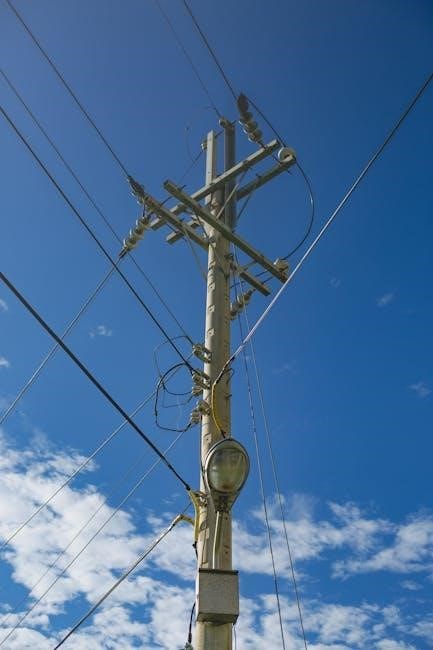
4.2 Handling Electrical Components
When handling electrical components of your 48V electric scooter, always disconnect the battery first to prevent shocks. Use insulated tools to avoid accidental short circuits. Ensure all connections are secure and properly insulated. Avoid touching electrical components with bare hands, as moisture can cause malfunctions. Keep the wiring harness away from heat sources and moving parts. Regularly inspect wires for signs of wear or damage. Never force connectors or wires into place, as this can cause permanent damage. Use a multimeter to test voltage and current before reconnecting components; If unsure about any procedure, consult the owner’s manual or seek professional assistance. Always follow proper safety protocols to ensure safe and reliable operation.

4.3 Emergency Procedures
In case of an electrical malfunction or accident, disconnect the battery immediately to prevent further damage or risk of shock. Move the scooter to a safe location away from traffic or flammable materials; Assess the situation to identify the source of the issue, such as a short circuit or overheating. If the problem is beyond your expertise, consult the owner’s manual or contact a professional. Always prioritize safety and avoid attempting repairs while the system is live. If injuries occur, seek medical attention promptly. Document the issue for future reference or warranty claims. Remember, electrical systems can be hazardous, so caution is paramount in emergencies.
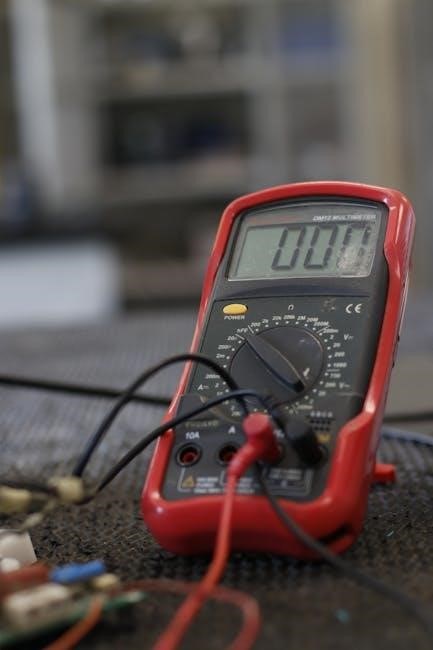
Installation and Setup Guide
This guide outlines the steps for setting up your 48V electric scooter, including unpacking, connecting the battery, and wiring components like the motor and throttle, ensuring a safe and efficient setup.

5.1 Unpacking and Inventory
When unpacking your 48V electric scooter, carefully inspect each component for damage. Ensure all items, such as the controller, wiring harness, battery, motor, and throttle, are included. Verify the wiring diagram matches the components in your kit. Organize small parts like connectors and screws to avoid misplacement. Check the owner’s manual for a detailed inventory list to confirm everything is accounted for. This step is crucial for a smooth installation process and ensures no essential parts are missing. If any discrepancies are found, contact the manufacturer immediately. Proper organization and verification will help you proceed confidently with the setup.
5.2 Connecting the Battery
Connecting the battery to your 48V electric scooter requires careful attention to ensure safety and proper function. Begin by locating the battery compartment and verifying the wiring diagram for correct connections. The positive terminal (typically red) should connect to the wiring harness’s positive lead, while the negative terminal (black) connects to the negative lead. Ensure all connections are secure and free from corrosion. If your scooter uses a battery management system (BMS), connect it according to the manual’s instructions. Always disconnect the battery before performing any electrical work and double-check the wiring diagram to avoid short circuits. Proper battery connection is vital for optimal performance and safety.
5;3 Wiring the Motor and Controller
Wiring the motor and controller is a critical step in setting up your 48V electric scooter. Begin by identifying the motor wires and matching them to the controller’s output terminals, ensuring proper phase connections. The hall sensor wires should be connected to the controller’s sensor inputs for accurate motor control. Refer to the wiring diagram to confirm the correct pin assignments. Securely connect the power lines from the battery to the controller, ensuring the positive (red) and negative (black) wires are correctly paired. Double-check all connections to avoid short circuits. Once connected, test the motor by gradually increasing the throttle to ensure smooth operation. Proper wiring ensures efficient power delivery and motor performance.
5.4 Integrating Throttle and Brake Systems
Integrating the throttle and brake systems ensures smooth control and safety. Connect the throttle to the controller by matching the hall sensor wires to the designated throttle input pins. The power wire (typically red) and ground wire (black) from the throttle should be connected to the controller’s throttle input terminals. For the brake system, attach the brake lever’s signal wire to the controller’s brake input, ensuring the power cutoff function works correctly. Use the wiring diagram to confirm connections. Secure all wires with heat shrink or electrical tape to prevent damage. Test the throttle and brake functions to ensure proper operation and safety before riding. Proper integration ensures reliable control and responsiveness.
Troubleshooting Common Issues
This section helps identify and resolve common issues like power loss, voltage drops, and connectivity faults. Use the wiring diagram to trace and fix electrical problems effectively.
6.1 Power Issues and Voltage Problems
Power issues and voltage problems are common in 48V electric scooters. Symptoms include inconsistent power delivery, sudden shutdowns, or complete loss of functionality. Check the battery charge level and ensure connections are secure. Voltage drops may occur due to faulty wiring or corroded terminals. Inspect the wiring harness for damage or wear, and verify that all connectors are properly seated. Use a multimeter to measure voltage at key points, such as the battery, controller, and motor. Compare readings to the specified 48V to identify discrepancies. Addressing these issues promptly prevents further damage and ensures optimal performance. Always consult the wiring diagram for precise troubleshooting guidance.
6.2 Motor Malfunction and Controller Errors
Motor malfunctions and controller errors can disrupt your scooter’s performance. Common issues include erratic motor behavior, loss of power, or error codes on the display. Check the wiring diagram to ensure all connections are secure and correctly routed. Verify the controller’s voltage and current settings match the motor’s specifications. Use a multimeter to test for short circuits or open lines in the motor windings. If the controller is faulty, consult the manual for reset procedures or consider replacing it. Ensure the battery voltage is within the recommended range (48V ± 1V) to prevent overvoltage or undervoltage conditions. Addressing these issues promptly ensures smooth operation and extends component lifespan.
6.3 Battery and Charging Faults
Battery and charging issues are common in 48V electric scooters. If the scooter won’t turn on, check the battery voltage using a multimeter. Ensure it reads between 47V and 49V for proper function. Charging faults may occur due to a damaged charging port, faulty charger, or incorrect voltage settings. Inspect the charging port for debris or corrosion and clean it if necessary. Verify the charger’s output matches the battery’s specifications. If the scooter shows error codes like E002 or E005, it may indicate a battery or charging system malfunction. Consult the wiring diagram to trace connections and test the charger’s output voltage. Replace faulty components or reset the controller if needed to restore functionality.
6.4 Brake and Throttle Connectivity Problems
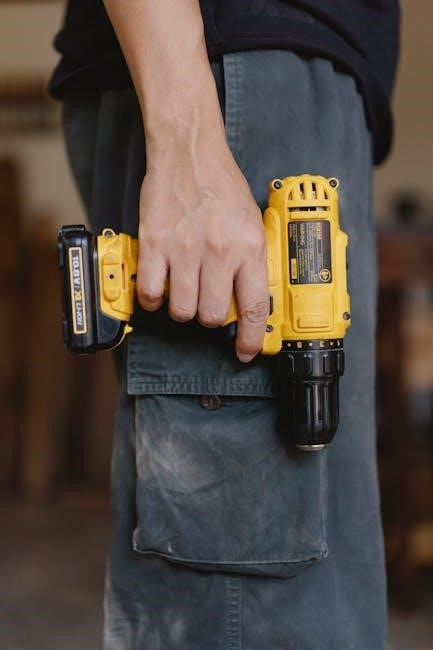
Brake and throttle connectivity issues can disrupt the scooter’s operation. Common problems include faulty connections, misconfigured wires, or damaged sensors. If the scooter accelerates unintentionally or the brakes fail to engage, inspect the throttle and brake wiring for loose connections or damage. Consult the wiring diagram to ensure proper connections between the controller, throttle, and brake sensors. Error codes like E002 or E005 may indicate connectivity issues. Test the voltage at the controller terminals using a multimeter to verify signal integrity. Clean or replace corroded connectors and ensure the brake and throttle sensors are properly calibrated. If issues persist, reset the controller or consult the owner’s manual for further troubleshooting steps.
Maintenance and Upkeep
Regular maintenance ensures optimal performance and longevity. Inspect wiring, clean connectors, and lubricate moving parts. Replace worn components and update firmware as needed for smooth operation.
7.1 Routine Checks and Inspections
Regular inspections are crucial for maintaining your 48V electric scooter. Start by examining the wiring harness for signs of wear, fraying, or corrosion. Ensure all connections are secure and free from debris. Check the battery terminals for tightness and cleanliness, as loose connections can cause power issues. Inspect the motor and controller for overheating signs, and verify that all sensors and indicators are functioning properly. Lubricate moving parts like the throttle and brakes to ensure smooth operation. Refer to the wiring diagram to trace connections and identify potential faults early. A thorough routine check helps prevent unexpected malfunctions and ensures safe riding.
7.2 Cleaning and Lubrication
Regular cleaning and lubrication are essential for maintaining your 48V electric scooter’s performance and longevity. Use a soft, dry cloth to wipe down the wiring harness, connectors, and battery terminals to prevent corrosion. For moving parts like the throttle, brakes, and suspension, apply a small amount of silicone-based lubricant to ensure smooth operation. Avoid using excessive grease, as it can attract dust and dirt. Clean the motor and controller fans to prevent overheating. Lubricate the chain or belt drive if applicable. Always refer to the wiring diagram to identify critical components that require attention. Proper maintenance ensures optimal functionality and extends the lifespan of your scooter.
7.3 Upgrading Components
Upgrading components on your 48V electric scooter can enhance performance, efficiency, and overall riding experience. When upgrading, always consult the wiring diagram to ensure compatibility and safety. Key components to consider upgrading include the motor, controller, battery, or wiring harness. A higher wattage motor or advanced controller can improve speed and torque, while a premium battery can extend range. Ensure all upgrades align with the scooter’s voltage and power specifications. Use high-quality connectors and follow proper installation procedures to avoid electrical issues. Testing the system post-upgrade is crucial to confirm everything functions as intended. Upgrades should be done carefully to maintain safety and reliability, ensuring your scooter operates at its best. Always refer to the manual for guidance.
Advanced Customization and Modifications
Explore advanced customization options for your 48V electric scooter, including motor upgrades, controller tuning, and custom wiring configurations to enhance performance and personalize your ride experience.
8.1 Upgrading the Motor and Controller
Upgrading the motor and controller on your 48V electric scooter can significantly enhance performance. Ensure the new motor is compatible with the 48V system and matches the power requirements. The controller must be appropriately sized to handle the increased power output. Replacing the wiring harness is recommended to avoid overheating and ensure reliable connections. Refer to the wiring diagram for proper connections, especially for hall sensors and phase wires. Testing the system at low power initially is crucial to verify functionality. Always follow safety guidelines and consult the manual for specific instructions to avoid damage or electrical hazards.
8.2 Enhancing Battery Performance
Enhancing battery performance in your 48V electric scooter involves optimizing its voltage and power output. Ensure the battery pack is properly balanced and maintained to avoid uneven discharge. Upgrading to a high-quality battery with a higher capacity can improve range and efficiency. Install a battery management system (BMS) to protect against overcharging and deep discharges. Regularly inspect and clean connections to prevent voltage drops. Avoid extreme temperatures and store the scooter in a cool, dry place. Use a compatible charger and monitor voltage levels during charging. These steps ensure reliable performance, extend battery life, and maintain safety. Always refer to the wiring diagram for proper connections.
